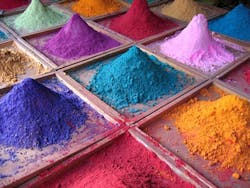Textiles: Passing the Test
The manufacturing of dyes in the textile industry requires the use of high concentrations of salts, such as sodium chloride. Therefore, salt removal and dye concentration is a necessary step in the preparation and purification of the final dye product. For this reason, membrane filtration plays an integral role in the reactive dye manufacturing process; dye desalting and concentration using nanofiltration is an effective means of improving dye strength, purity and value compared to thermal evaporation using spray dryers.
In this case study, the performance of Synder’s NDX membrane was evaluated in a dye desalting and dye concentration application using a simulated feed stream with Reactive Red 195 (RR195) as a model reactive dye and sodium chloride as the model salt used for dye precipitation in the synthesis process. Flat sheet testing was also performed to evaluate the flux and rejection performance of NDX to that of a leading competitor.
Performing the Experiment
Synder NDX-2-2540 elements, manufactured in Vacaville, Calif., were used in this study. Each element contained a 31-mil feed spacer and an active membrane area of 28 sq ft. Polyethylene glycol (PEG) 1kDa was obtained from Sigma Aldrich (St. Louis), and sodium chloride was obtained from Alfa Aesar (Ward Hill, Mass.). The model reactive dye used for evaluation was 190% strength RR195 (Custom Colours Inc, Mooresville, N.C.). Deionized water was used for all experiments. All testing was performed at Synder Headquarters in Vacaville, Calif.
Initial flat sheet testing was performed to screen the flux and rejection performance of NDX. Sodium chloride and PEG1kDa rejection was tested at 2,000 ppm concentration, and RR195 was tested at 1 wt% (weight percent). Testing was conducted in a flat-sheet crossflow filtration unit with an active membrane area of 4.1 sq in. Membranes were compacted at 110psi and a crossflow rate of 0.5 gal per minute (gpm) at 25°C for 15 minutes prior to sample collection. PEG and sodium chloride rejection was determined using total organic carbon and conductivity, respectively. Dye rejection was calculated based on Abs500, Abs 525, and Abs550, using pre-established standard curves.
NDX-2-2540TM elements underwent evaluation at 120 psi at a feed flow rate of 4 gpm at 25°C in a NF-201-2540-IND-SS304 industrial-grade nanofiltration pilot system. The system used in this study is a capable of housing a single 2540 spiral-wound element and was equipped with a 25-µ bag filter. The simulated feed stream was comprised of 3-wt% RR195 dye and 5wt% sodium chloride. The system was operated in batch mode, and testing was performed through six times volume concentration factor (VCF) without the use of diafiltration. RR195 and sodium rejection, as well as permeate flux, were monitored through the duration of testing. Three different elements were evaluated for these trials. Dye rejection was determined via Abs525, and sodium concentration was determined via inductively coupled plasma by Pace Analytical Laboratories.
Reading the Results
Flux and rejection values for NDX and the competitor were evaluated with sodium chloride, PEG1kDa and RR195. Both membranes exhibited similar rejection of all three solutes when tested under the same conditions. However, the observed permeate flux for NDX was at least five times greater than that observed for the leading competitor. Despite minute differences in dye concentration between permeate samples of the two membranes, resulting in similar calculated dye rejection values, the visual difference in sample quality between the two was more pronounced.
Measured dye rejection for NDX was consistent at greater than 99.9% for all tested concentration factors through six times VCF. Sodium rejection was observed to increase slightly over the duration of testing but remained less than 22% by the end of the study. The rise in sodium rejection can be explained by the increase in dye concentration and absence of a diafiltration step. Further utilization of diafiltration may be used to enhance salt reduction and increase product recovery at higher concentration factors.
At a constant pressure and flow rate of 120 psi and 4 gpm, permeate flux declined from an initial average of 26 gal per sq ft per day (gfd) to 17 gfd at 6x VCF. Temperature was also held constant at 25 ± 5°C.
NDX 2540 elements exhibited consistently high dye rejection and high salt passage rates through six times VCF in a simulated feed stream comprised of 3% RR195 dye and 5% sodium chloride.
Despite a high concentration of dissolved solids, NDX demonstrates solid flux performance under relatively low operating pressures, thereby offering increased throughput compared to other commercially available membranes for dye desalting. Additional field trials at a dyestuffs manufacturer in India also have demonstrated that Synder’s NDX membrane is capable of providing equivalent, if not better, performance with respect to dye rejection, dye purity and flux compared to that of the competitor. These results indicate that the NDX membrane is well-suited for dye concentration and desalting applications throughout the textile and dye industry.
Download: Here
